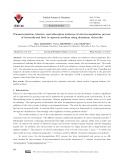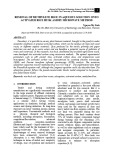
The adsorption data
-
Part 1 book "Powder surface area and porosity" includes content: Introduction; gas adsorption; adsorption isotherms; langmuir and bet theories; the single point bet method; adsorbate cross sectional areas; other surface area methods; pore analysis by adsorption; microporosity; theory of wetting and capillarity for mercury porosimetry; interpretation of mercury porosimetry data; hysteresis, entrapment, and contact angle.
 149p
149p  muasambanhan06
muasambanhan06
 03-02-2024
03-02-2024
 2
2
 1
1
 Download
Download
-
Ebook "Modification of magnetic properties of iron clusters by doping and adsorption: From a few atoms to nanoclusters" is based on computations performed on unary neutral and charged iron clusters, binary iron clusters, and iron clusters interacting with carbon and oxygen atoms as well as with a number of diatomics and water. The author considers geometrical structure, thermodynamic stability and electronic properties which are compared with experimental data.
 85p
85p  lamquandat
lamquandat
 28-12-2023
28-12-2023
 5
5
 2
2
 Download
Download
-
In study "Using quail eggshell to treat methylene blue in aqueous solution", the raw quail eggshell powder (RQEP) was utilized as a cheap and environmentally friendly adsorbent to remove methylene blue (MB) from aqueous media under different conditions. The morphology of the prepared adsorbent was determined by scanning electron microscopy. The Langmuir and Freundlich isotherm models were used to model the adsorption data. The obtained results showed that the adsorption of MB on RQEP was well-fitted with the Freundlich model.
 8p
8p  nhanchienthien
nhanchienthien
 25-07-2023
25-07-2023
 4
4
 3
3
 Download
Download
-
In this study, the sugarcane bagasse grafted with citric acid was used as a low-cost biosorbent for removal of dyes from the textile wastewater. The adsorption parameters such as initial pH values, dyes concentrations, adsorbent dosages and contact times were investigated by the batch experiments. The Freundlich and Langmuir adsorption isotherm models were used to evaluate the experimental data.
 6p
6p  vidoctorstrange
vidoctorstrange
 06-05-2023
06-05-2023
 6
6
 2
2
 Download
Download
-
In this study, the removal of DMDS was investigated by adsorption on activated carbon cloth (ACC) in the gas phase. Kinetics and isotherm studies were performed. Adsorption kinetics followed by GC-MS and the data were processed using different models. When correlation coefficients (R2 ) of linear regression analysis are analyzed, it is seen that the concordance of experimental data to the pseudo-second-order equation is quite good.
 10p
10p  lyhuyenthu
lyhuyenthu
 31-01-2023
31-01-2023
 8
8
 2
2
 Download
Download
-
CO adsorption on the Cu(211) surface was investigated using energy, geometry and vibrational data, which were produced through periodic DFT computations. Adsorption on the (111) terrace, as well as the previously reported top and bridge sites of the stepedges, was studied at 0.25, 0.33, 0.50, 0.66, 0.75, and 1.00 monolayer (ML) CO coverage. Results showed that up to and including 0.50 ML, on-top or bridge adsorption is preferred on the step-edges.
 13p
13p  lyhuyenthu
lyhuyenthu
 31-01-2023
31-01-2023
 3
3
 2
2
 Download
Download
-
A new method is outlined for constructing realistic models of the mesoporous amorphous silica adsorbent, MCM-41. The procedure uses the melt-quench molecular dynamics technique. Previous methods are either computationally expensive or overly simplified, missing key details necessary for agreement with experimental data.
 9p
9p  vironald
vironald
 15-12-2022
15-12-2022
 5
5
 2
2
 Download
Download
-
The adsorption and mass transport of CO2 and CH4 in CHA zeolite were studied experimentally. First, large and well-defined CHA crystals with varying Si/Al ratios and morphologies ideal for adsorption studies were prepared. Then, adsorption isotherms were measured, and adsorption parameters were estimated from the data.
 13p
13p  vironald
vironald
 15-12-2022
15-12-2022
 4
4
 2
2
 Download
Download
-
The mechanism of dye-adsorbent interaction is described on the basis of zero-point charge and zeta potential techniques. Batch adsorption studies on MCH NM show excellent adsorption activity of 199.02 mg/g in 22 min towards RB13 dye, maximum value ever reported for any reactive dye. Equilibrium adsorption data and adsorption kinetics were well fitted into Langmuir isotherm model and pseudo second order model predicting chemically rate controlled monolayer adsorption.
 9p
9p  thebadguys
thebadguys
 15-01-2022
15-01-2022
 12
12
 1
1
 Download
Download
-
A series of batch lab-scale experiments were performed to investigate the performance of dead phosphorylated algal biomass of Spirogyra species for the bioadsorption of Cu +2 ions from aqueous solutions. FT-IR and SEM analyses were performed to characterize the phosphorylated and raw algae. The SEM analysis indicated that the phosphorus content increases by about 5 times. The isotherm equilibrium data indicated that phosphorylation enhances the removal of Cu +2 from water by about 20%. The experimental isotherms fit well to Langmuir models with R 2 values close to 0.99.
 19p
19p  langthannam
langthannam
 29-12-2021
29-12-2021
 9
9
 0
0
 Download
Download
-
This study deals with the adsorption of two pesticides, carbendazim and flumetsulam, from aqueous solutions onto four homoionic-montmorillonite clays (Ag+, Zn2+, Cu 2+, and H+). Equilibrium adsorption isotherm data were analyzed using Freundlich, Dubinin–Radushkevich, and Temkin isotherms. Linear and nonlinear fitting methods were compared to determine the best-fitting isotherms for the experimental data. Three error analysis methods were used to evaluate the data for each method: the coefficient of determination (R2), sum of squared errors (SSE), and chi-square test (χ2).
 11p
11p  tudichquannguyet
tudichquannguyet
 29-11-2021
29-11-2021
 8
8
 1
1
 Download
Download
-
Adsorption processes of Cd(II) and Pb(II) from aqueous solutions onto pumice stone powder (PSP) were investigated in batch mode. The influences of solution pH, contact time, adsorbent dosage, initial metal (M) concentration, and temperature on adsorption process were investigated. The kinetic and isotherm data were analysed using different model equations. The adsorption process was consistent with the Langmuir model for both metal ions with high R2 and low χ2 values for both Pb(II) and Cd(II). The maximum monolayer adsorption capacities were 28.09 and 27.
 12p
12p  tudichquannguyet
tudichquannguyet
 29-11-2021
29-11-2021
 14
14
 0
0
 Download
Download
-
Cocondensation and postfunctionalization methods were employed to synthesize a mesoporous silica with large surface area (795.1 ± 1.1 m2 g −1 ) modified with 4-amino-5-hydrazino-1,2,4-triazole-3-thiol, which was successfully applied to adsorb and preconcentrate Cu(II), Co(II), and Cd(II) from aqueous media. Infrared spectroscopy of the adsorbent material demonstrated N-H stretching bonds related to primary amines existing in the ligand molecule, elemental analysis revealed the presence of 0.
 15p
15p  tudichquannguyet
tudichquannguyet
 29-11-2021
29-11-2021
 9
9
 2
2
 Download
Download
-
In the present study, calcined layered double hydroxides (CLDHs) were obtained by heating [Zn2-Al-CO3 ] at 500◦C. The adsorption of the textile dye acid green 1 (AG1) by CLDH was carried out at different pH levels, adsorbent–adsorbate contact times, and AG1/CLDH mass ratios. Equilibrium at room temperature was reached after 24 h, which was confirmed by the kinetic modeling of the experimental data by the pseudo-second-order model. The adsorption is described by a Langmuir-type isotherm.
 15p
15p  tudichquannguyet
tudichquannguyet
 29-11-2021
29-11-2021
 9
9
 1
1
 Download
Download
-
In this study, natural clinoptilolite was modified by saponin and Brij 35 surfactants to remove diethylstilbestrol (DES) from wastewater in batch and continuous systems. The optimum pH, amount of adsorbent, contact time, and temperature were 11, 10 g/L, 12 h, and 35°C, respectively, for the process. The equilibrium data agreed well with the Langmuir isotherm for natural clinoptilolite (NC), natural clinoptilolite modified by Brij 35 (NC-Brij), and natural clinoptilolite modified by saponin surfactants (NC-saponin) compared to other isotherms.
 24p
24p  tudichquannguyet
tudichquannguyet
 29-11-2021
29-11-2021
 12
12
 1
1
 Download
Download
-
In wastewater treatment, scientific and practical models utilizing numerical computational techniques such as artificial neural networks (ANNs) can significantly help to improve the process as a whole through adsorption systems. In the modeling of the adsorption efficiency for heavy metals from wastewater, some kinetic models have been used such as pseudo first-order and second-order. The present work develops an ANN model to forecast the adsorption efficiency of heavy metals such as zinc, nickel, and copper by extracting experimental data from three case studies.
 20p
20p  tudichquannguyet
tudichquannguyet
 29-11-2021
29-11-2021
 9
9
 1
1
 Download
Download
-
A review of the studies dealing with the removal of chromium, cadmium, and nickel ions with different adsorbents published in the literature between 2014 and 2018 is given in tabular form, along with the adsorption conditions, adsorption isotherm, and kinetic models applied by the authors to model the experimental data and adsorption capacities. The review focuses on the efficiency of ion removal.
 25p
25p  tudichquannguyet
tudichquannguyet
 29-11-2021
29-11-2021
 8
8
 1
1
 Download
Download
-
The removal of bromothymol blue (BTB) from aqueous solution was studied by electrocoagulation (EC) technique using aluminum electrodes. The various experimental conditions known to influence the EC process were parameterized, including the effects of temperature, concentration, current density, pH, and treatment time. The results obtained have shown that optimum removal efficiency of 99.9% was realized at a current density of 20 mA/cm2 and pH of 4.7. The adsorption process showed a pseudo-first-order kinetic model as the best fit to the EC data.
 21p
21p  tudichquannguyet
tudichquannguyet
 29-11-2021
29-11-2021
 15
15
 1
1
 Download
Download
-
The obtained results indicated that the pomelo fruit peel is a potential biosorbent to uptake heavy toxic metals and organic molecules from aqueous solutions. Therefore, in this work, the study is extended to Ni(II) adsorption onto the pomelo fruit peel. The pHsolution, adsorption time, and initial Ni(II) concentration, all of which affect the Ni(II) adsorption, are examined. Some common isotherm and kinetic models are fit to the experimental data to understand the nature of the uptake.
 6p
6p  nguaconbaynhay12
nguaconbaynhay12
 13-06-2021
13-06-2021
 17
17
 1
1
 Download
Download
-
In this research, rice husk, abandoned and available agriculture waste, were developed into activated carbon using microwave methods. The optimal experimental parameters such as pH, contact time, activated carbon dose, and temperature were investigated. The activated carbon was characterized by scanning electron microscopy (SEM), and Fourier transform infrared spectroscopy (FTIR) analysis. The maximum adsorption capacities toward methylene blue was 6.13 mg g-1 . The experimental data fitted the Freundlich equation well, although the Langmuir equation could also describe them.
 5p
5p  caygaocaolon11
caygaocaolon11
 18-04-2021
18-04-2021
 13
13
 2
2
 Download
Download
CHỦ ĐỀ BẠN MUỐN TÌM










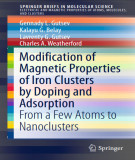
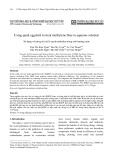
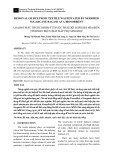
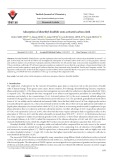
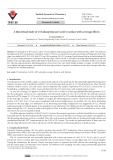
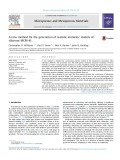
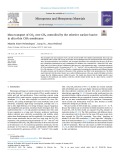





![Use of calcined layered double hydroxide [Zn2-Al-CO3] for removal of textile dye acid green 1 from wastewater: Kinetic, equilibrium, comparative, and recycling studies Use of calcined layered double hydroxide [Zn2-Al-CO3] for removal of textile dye acid green 1 from wastewater: Kinetic, equilibrium, comparative, and recycling studies](https://tailieu.vn/image/document/thumbnail/2021/20211129/tudichquannguyet/135x160/3351638156012.jpg)



